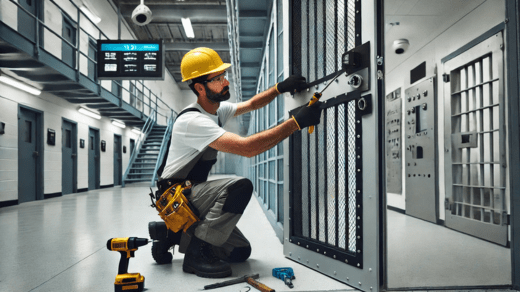Aging detention facilities face a growing list of security concerns, from failing locks to outdated surveillance systems. Upgrades are not just about modernizing but ensuring the safety of staff and inmates while maintaining strict security measures. Detention equipment contractors play a vital role in transforming outdated structures into secure, efficient, and compliant facilities.
Assessing Structural Weaknesses That Compromise Security
Many older correctional facilities were built decades ago with materials and designs that no longer meet today’s security demands. Walls, doors, and barriers weaken over time, creating vulnerabilities that can lead to breaches, escapes, or internal disturbances. Detention equipment contractors specialize in identifying these structural weaknesses and providing solutions that strengthen the facility’s overall security.
A security detention equipment contractor conducts detailed inspections to locate compromised areas, such as deteriorating concrete, rusted door frames, and outdated barriers. These weak points may not be obvious at first glance but can become major security risks if left unaddressed. By reinforcing these structures with high-strength materials and advanced designs, contractors help correctional facilities prevent potential threats while extending the life of the building.
Upgrading Outdated Locking Systems for Modern Threat Protection
Locks are the backbone of any detention facility, but older systems often lack the technology and reliability needed to handle modern security threats. Mechanical locks wear down, electronic systems become outdated, and poor maintenance can lead to frequent failures. Detention equipment contractors upgrade these systems with high-security electronic locks, tamper-resistant mechanisms, and fail-safe solutions that improve overall control.
Beyond just replacing old locks, a security detention equipment contractor integrates new access control methods that prevent unauthorized movement within the facility. Advanced keyless entry systems, biometric access points, and remotely operated cell doors allow staff to maintain control with greater efficiency. These upgrades not only enhance security but also improve staff response times in critical situations, ensuring a safer environment for everyone inside the facility.
Enhancing Surveillance Integration Without Disrupting Operations
Older surveillance systems often struggle with blind spots, poor image quality, and unreliable data storage. Security upgrades require careful planning to ensure new systems enhance security without disrupting daily operations. Detention equipment contractors specialize in integrating modern surveillance solutions that provide real-time monitoring, better image clarity, and secure data management.
A well-planned surveillance upgrade includes high-definition cameras, motion detection technology, and AI-powered monitoring systems. A security detention equipment contractor ensures that these upgrades work seamlessly with existing infrastructure, minimizing downtime and keeping operations running smoothly. With improved surveillance, facilities gain better control over inmate behavior, staff safety, and incident response.
Replacing Deteriorating Materials with Stronger, Tamper-Resistant Alternatives
Time and constant use take a toll on detention facility materials. Doors, walls, and windows weaken, making them more susceptible to tampering or forced entry. Regular maintenance can only do so much before full replacements are necessary. Detention equipment contractors provide upgraded materials that resist tampering, reduce maintenance costs, and improve overall security.
Using reinforced steel, impact-resistant glass, and high-strength composite materials, a security detention equipment contractor replaces failing components with ones built to withstand the demands of correctional environments. These materials not only improve durability but also enhance fire resistance, noise reduction, and thermal insulation, creating a more secure and manageable facility.
Customizing Security Solutions for Aging Facilities with Unique Layouts
No two detention facilities are the same, especially when dealing with older buildings that have undergone multiple modifications. Standardized security solutions don’t always fit these spaces, requiring a more customized approach. Detention equipment contractors assess facility layouts and develop tailored security enhancements that work within the existing structure.
Whether it’s adapting modern cell doors to an outdated wing, integrating new technology into a historic facility, or designing escape-proof barriers for an irregular layout, a security detention equipment contractor ensures each upgrade improves security without unnecessary reconstruction. These custom solutions provide a cost-effective way to modernize older facilities without compromising safety or operational efficiency.
Improving Access Control Systems to Streamline Staff Efficiency
Managing movement within a detention facility requires precise access control. Older systems often rely on manual processes, which can slow down staff response times and increase security risks. Modernizing access control not only improves security but also enhances staff efficiency by reducing bottlenecks and simplifying daily operations.
Detention equipment contractors upgrade facilities with electronic key systems, biometric entry points, and centralized control panels that allow staff to monitor and manage access with ease. A security detention equipment contractor ensures that these systems integrate with existing security measures, reducing the risk of human error while improving overall facility management. By streamlining access control, facilities can operate more smoothly while maintaining strict security protocols.

